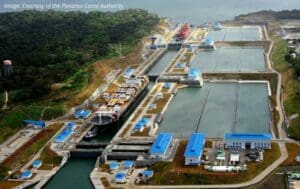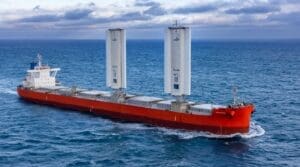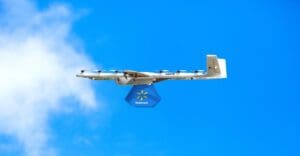 St. Patrick’s Day is this Sunday, and consumers are doing more than just wearing green – they are spending lots of green as well. According to its annual survey, the National Retail Federation (NRF) indicates that consumers plan to spend a record $7.2 billion — or an average of $44.40 per person — on the holiday this year and, perhaps unsurprisingly, their top spending categories are food and beverages. More so, a record 62 percent or 162 million Americans are planning to celebrate. But just how do they plan on celebrating? Well, 82 percent of survey respondents plan to wear green, 29 percent will make a special dinner, 27 percent will attend a party at a bar or restaurant, 26 percent will decorate their home or office, 16 percent will attend a private party, 15 percent will attend a parade, 12 percent will host a party. Whatever you plan to do this weekend, we wish you a Happy St. Patrick’s Day, and say Sláinte! And now on to this week’s logistics news.
St. Patrick’s Day is this Sunday, and consumers are doing more than just wearing green – they are spending lots of green as well. According to its annual survey, the National Retail Federation (NRF) indicates that consumers plan to spend a record $7.2 billion — or an average of $44.40 per person — on the holiday this year and, perhaps unsurprisingly, their top spending categories are food and beverages. More so, a record 62 percent or 162 million Americans are planning to celebrate. But just how do they plan on celebrating? Well, 82 percent of survey respondents plan to wear green, 29 percent will make a special dinner, 27 percent will attend a party at a bar or restaurant, 26 percent will decorate their home or office, 16 percent will attend a private party, 15 percent will attend a parade, 12 percent will host a party. Whatever you plan to do this weekend, we wish you a Happy St. Patrick’s Day, and say Sláinte! And now on to this week’s logistics news.

 More than 50 ships queued to cross the Panama Canal on a recent day—from tankers hauling propane to cargo ships packed with food. A prolonged drought has led the canal’s operator to cut the number of crossings, resulting in longer waits. The tolls that ships pay are now around eight times more expensive than normal. Over 7,000 miles away, vessels that move containers through Egypt’s Suez Canal are waiting for naval escorts or avoiding the passage altogether to take a much longer voyage around South Africa. Ship operators fear that their crews could be imperiled on the journeys through the Red Sea by missile or drone attacks from a Yemen-based rebel group. The Suez’s problems are geopolitical and those in Panama are climate-based, but both are roiling global trade. Cargo volumes through the Suez and Panama canals have plunged by more than a third. Hundreds of vessels have diverted to longer routes, resulting in delivery delays, higher transportation costs and economic wreckage for local communities.
More than 50 ships queued to cross the Panama Canal on a recent day—from tankers hauling propane to cargo ships packed with food. A prolonged drought has led the canal’s operator to cut the number of crossings, resulting in longer waits. The tolls that ships pay are now around eight times more expensive than normal. Over 7,000 miles away, vessels that move containers through Egypt’s Suez Canal are waiting for naval escorts or avoiding the passage altogether to take a much longer voyage around South Africa. Ship operators fear that their crews could be imperiled on the journeys through the Red Sea by missile or drone attacks from a Yemen-based rebel group. The Suez’s problems are geopolitical and those in Panama are climate-based, but both are roiling global trade. Cargo volumes through the Suez and Panama canals have plunged by more than a third. Hundreds of vessels have diverted to longer routes, resulting in delivery delays, higher transportation costs and economic wreckage for local communities.
The Biden administration is expected to soon issue a strategy for placing charging infrastructure for electric freight trucks in strategic and busy corridors. Proponents of this approach argue that it could allow for more infrastructure to be available where a lot of trucking occurs, possibly making it easier for companies to invest in electric trucks rather than gas-powered trucks. Criticism from the trucking industry of the rule has included that it underestimates the costs and feasibility challenges of building up significant truck charging infrastructure — a complaint the anticipated strategy may aim to combat. One source said that the strategy could be announced Tuesday.

 A shipping vessel left China for Brazil while sporting some new improvements last August—a pair of 123-feet-tall, solid “wings” retrofitted atop its deck to harness wind power for propulsion assistance. But after its six-week maiden voyage testing the green energy tech, the Pyxis Ocean MC Shipping Kamsarmax vessel apparently had many more trips ahead of it. Six months later, its owners at the shipping company, Cargill, shared the results of those journeys this week—and it sounds like the vertical WindWing sails could offer a promising way to reduce existing vessels’ emissions. Using the wind force captured by its two giant, controllable sails to boost its speed, Pyxis Ocean reportedly saved an average of 3.3 tons of fuel each day. And in optimal weather conditions, its trips through portions of the Indian, Pacific, and Atlantic Oceans reduced fuel consumption by over 12 tons a day. According to Cargill’s math, that’s an average of 14 percent less greenhouse gas emissions from the ship. On its best days, Pyxis Ocean could cut that down by 37 percent. In all, the WindWing’s average performance fell within 10 percent ts designers’ computational fluid dynamics simulation predictions.
A shipping vessel left China for Brazil while sporting some new improvements last August—a pair of 123-feet-tall, solid “wings” retrofitted atop its deck to harness wind power for propulsion assistance. But after its six-week maiden voyage testing the green energy tech, the Pyxis Ocean MC Shipping Kamsarmax vessel apparently had many more trips ahead of it. Six months later, its owners at the shipping company, Cargill, shared the results of those journeys this week—and it sounds like the vertical WindWing sails could offer a promising way to reduce existing vessels’ emissions. Using the wind force captured by its two giant, controllable sails to boost its speed, Pyxis Ocean reportedly saved an average of 3.3 tons of fuel each day. And in optimal weather conditions, its trips through portions of the Indian, Pacific, and Atlantic Oceans reduced fuel consumption by over 12 tons a day. According to Cargill’s math, that’s an average of 14 percent less greenhouse gas emissions from the ship. On its best days, Pyxis Ocean could cut that down by 37 percent. In all, the WindWing’s average performance fell within 10 percent ts designers’ computational fluid dynamics simulation predictions.

 Attention to drone delivery heated up for many companies during the Covid-19 pandemic, when a surge in online orders pushed more goods into trucks, cars and bikes, adding congestion and pollution on roads. Advocates say the technology is environmentally friendly since the devices typically are battery-powered, reducing emissions for filling orders. The Federal Aviation Administration, overseer of the nation’s skies, in the past year has given companies including Wing, a unit of Alphabet, and autonomous drone operator Zipline permission to fly their drones beyond so-called visual line of sight. The requirement that drones remain in sight of a human operator has been a major hurdle for drone operations.
Attention to drone delivery heated up for many companies during the Covid-19 pandemic, when a surge in online orders pushed more goods into trucks, cars and bikes, adding congestion and pollution on roads. Advocates say the technology is environmentally friendly since the devices typically are battery-powered, reducing emissions for filling orders. The Federal Aviation Administration, overseer of the nation’s skies, in the past year has given companies including Wing, a unit of Alphabet, and autonomous drone operator Zipline permission to fly their drones beyond so-called visual line of sight. The requirement that drones remain in sight of a human operator has been a major hurdle for drone operations.
Contract talks at East Coast and Gulf Coast ports are starting this year under very different circumstances than the West Coast negotiations that rattled supply chains over the past two years. Cargo bottlenecks that left imports tied up at sea and at ports have largely cleared while record earnings for ocean carriers, a source of rancor during the West Coast talks, are dissipating in a vastly changed freight market. The International Longshoremen’s Association is seeking to build on strong wage gains other transportation unions have won. The dockworkers’ union is already threatening a strike against shipping companies and port employers if a deal on a new multiyear contract can’t be reached before the current agreement expires September 30. Harold Daggett, the ILA’s combative president, told dockworkers at a protest in January outside the Manhattan offices of wind energy giant Orsted, that the forthcoming contract would be the best the union ever had. “Just remember, when we shut down, this whole f—ing world shuts down,” Daggett said. “They don’t realize how f—ing strong we are.“

 Mack Trucks will introduce an off-grid charging unit that is attached to an MD Electric, the OEM said March 5, as it attempts to drum up interest in the recently introduced Class 6 or 7 vehicle. The unit can charge two MD Electrics at once and will be integrated into the body of a truck. It comprises a renewable propane tank, a generator and a 120 kilowatt-charger integrated into the chassis. The Level 3 charger is an ABB unit. Mack is offering the trucks to customers testing the MD Electric as well as dealers facilitating electric vehicle demos. Mack does not currently plan to make the truck-charger configuration commercially available to customers but is offering to support buyers interested in obtaining a truck charger combo through their dealer. MD Electric production has started, and it is undergoing upfitting, Saba said. The truck will be available to customers by the end of the first half of the year.
Mack Trucks will introduce an off-grid charging unit that is attached to an MD Electric, the OEM said March 5, as it attempts to drum up interest in the recently introduced Class 6 or 7 vehicle. The unit can charge two MD Electrics at once and will be integrated into the body of a truck. It comprises a renewable propane tank, a generator and a 120 kilowatt-charger integrated into the chassis. The Level 3 charger is an ABB unit. Mack is offering the trucks to customers testing the MD Electric as well as dealers facilitating electric vehicle demos. Mack does not currently plan to make the truck-charger configuration commercially available to customers but is offering to support buyers interested in obtaining a truck charger combo through their dealer. MD Electric production has started, and it is undergoing upfitting, Saba said. The truck will be available to customers by the end of the first half of the year.
Kohl’s said Tuesday that it’s teaming up with the owner of Babies R Us to bring baby gear, furniture and more to approximately 200 of its stores across the country. The retailer struck a licensing deal with WHP Global, a brand management firm with a portfolio that includes Bonobos, Joe’s Jeans and Anne Klein. The two companies did not disclose the terms of the agreement. Kohl’s said the first Babies R Us shops will open this August and expand to more stores in the fall. The shops will range from 750 to 2,500 square feet, and will add more brands and merchandise to Kohl’s baby category. The new shops will be set up next to the baby merchandise that the retailer already carries, including clothes and items from Graco, Carter’s and Fisher-Price. Later this fall, customers will also see an expanded assortment of baby products on Kohl’s website, and the company will launch a baby registry, its new CEO, Tom Kingsbury, said on an earnings call.
That’s all for this week. Enjoy the weekend and the song of the week, Sally MacLennane by the Pogues.




















